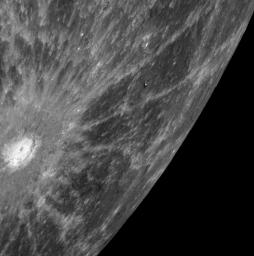“A” Spectacular Rayed Crater
Caption:
This NAC image shows a bright crater with an extensive system of impact ejecta rays; the crater is also clearly visible on the southern portion of Mercury near the limb of the planet in the departure full-planet image (
PIA11245
). This impact crater and its associated system of rays were originally detected in 1969 as a "bright feature" in radar images at 12.5-centimeter wavelength obtained by the Goldstone Observatory in California. Subsequently, about a decade ago, radar images acquired by the Arecibo Observatory in Puerto Rico clearly revealed this feature to be a crater with a fresh system of rays of rough material radiating outward from it. This feature has been referred to simply as feature "A." MESSENGER's recent Mercury flyby provided the first spacecraft images of feature "A," enabling this relatively young crater with its impressive set of rays to be seen here in close-up detail.
Date Acquired:
October 6, 2008
Image Mission Elapsed Time (MET):
131773947
Instrument:
Narrow Angle Camera (NAC) of the Mercury Dual Imaging System (MDIS)
Resolution:
530 meters/pixel (0.33 miles/pixel)
Scale:
The bright rayed crater is approximately 80 kilometers (50 miles) in diameter
Spacecraft Altitude:
20,600 kilometers (12,800 miles)
Background Info:
These images are from MESSENGER, a NASA Discovery mission to conduct the first orbital study of the innermost planet, Mercury. For information regarding the use of images, see the MESSENGER
image use policy
.
Cataloging Keywords:
| Name |
Value |
Additional Values |
| Target |
Mercury |
|
| System |
|
|
| Target Type |
Planet |
|
| Mission |
MESSENGER |
National Astronomy and Ionosphere Center (NAIC) |
| Instrument Host |
MESSENGER |
Arecibo Observatory |
| Host Type |
Orbiter |
Ground-Based Observatory |
| Instrument |
Mercury Dual Imaging System (MDIS) |
Arecibo Radar |
| Detector |
Narrow Angle Camera (NAC) |
|
| Extra Keywords |
Crater, Grayscale, Impact, Radar |
| Acquisition Date |
|
| Release Date |
2008-10-20 |
| Date in Caption |
2008-10-06 |
|
| Image Credit |
NASA/Johns Hopkins University Applied Physics Laboratory/Carnegie Institution of Washington |
| Source |
photojournal.jpl.nasa.gov/catalog/PIA11371 |
| Identifier |
PIA11371 |

 Planetary Data System
Planetary Data System
